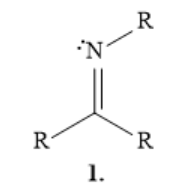1. Imines and enamines are both functional groups that can be synthesized from aldehydes or ketones. However, imines can only be synthesized from primary amines, while enamines can only be synthesized from secondary amines. a. (i) Write a full, complete mechanism for the formation of an imine from a primary amine and a ketone. (ii) Indicate all mechanism arrows, charges, and lone electrons. Do not show transition states. b. Using the mechanism you just wrote above, explain why an imine cannot be synthesized from a secondary amine. Note: To save time, you do not have to write another full mechanism. c. Although there is no mechanistic reason why enamines cannot be synthesized from primary amines, if such enamines are somehow formed they would rapid transform into another functional group. (i) Draw the structure of an enamine that is formed from a primary amine. Then, (ii) write a complete mechanism for the transformation that would occur to such an enamine. Finally, (iii) state the name of this type of transformation and briefly explain why this transformation occurs.
1. Imines and enamines are both functional groups that can be synthesized from aldehydes or ketones. However, imines can only be synthesized from primary amines, while enamines can only be synthesized from secondary amines. a. (i) Write a full, complete mechanism for the formation of an imine from a primary amine and a ketone. (ii) Indicate all mechanism arrows, charges, and lone electrons. Do not show transition states. b. Using the mechanism you just wrote above, explain why an imine cannot be synthesized from a secondary amine. Note: To save time, you do not have to write another full mechanism. c. Although there is no mechanistic reason why enamines cannot be synthesized from primary amines, if such enamines are somehow formed they would rapid transform into another functional group. (i) Draw the structure of an enamine that is formed from a primary amine. Then, (ii) write a complete mechanism for the transformation that would occur to such an enamine. Finally, (iii) state the name of this type of transformation and briefly explain why this transformation occurs.
Chemistry
10th Edition
ISBN:9781305957404
Author:Steven S. Zumdahl, Susan A. Zumdahl, Donald J. DeCoste
Publisher:Steven S. Zumdahl, Susan A. Zumdahl, Donald J. DeCoste
Chapter1: Chemical Foundations
Section: Chapter Questions
Problem 1RQ: Define and explain the differences between the following terms. a. law and theory b. theory and...
Related questions
Question
help

Transcribed Image Text:1. Imines and enamines are both functional groups that can be synthesized from aldehydes or ketones. However, imines can
only be synthesized from primary amines, while enamines can only be synthesized from secondary amines.
a. (i) Write a full, complete mechanism for the formation of an imine from a primary amine and a ketone. (ii) Indicate
all mechanism arrows, charges, and lone electrons. Do not show transition states.
b. Using the mechanism you just wrote above, explain why an imine cannot be synthesized from a secondary amine.
Note: To save time, you do not have to write another full mechanism.
c. Although there is no mechanistic reason why enamines cannot be synthesized from primary amines, if such
enamines are somehow formed they would rapid transform into another functional group. (i) Draw the structure of
an enamine that is formed from a primary amine. Then, (ii) write a complete mechanism for the transformation that
would occur to such an enamine. Finally, (iii) state the name of this type of transformation and briefly explain why
this transformation occurs.
Expert Solution
Step 1
The structures of an imine (1) and an enamine (2) respectively, are as follows:


The imine contains a double bond between the C-atom and the N-atom whereas in enamine, the N-atom is present next to the C-atom which is doubly bonded to the other C-atom.
Trending now
This is a popular solution!
Step by step
Solved in 3 steps with 4 images

Knowledge Booster
Learn more about
Need a deep-dive on the concept behind this application? Look no further. Learn more about this topic, chemistry and related others by exploring similar questions and additional content below.Recommended textbooks for you

Chemistry
Chemistry
ISBN:
9781305957404
Author:
Steven S. Zumdahl, Susan A. Zumdahl, Donald J. DeCoste
Publisher:
Cengage Learning

Chemistry
Chemistry
ISBN:
9781259911156
Author:
Raymond Chang Dr., Jason Overby Professor
Publisher:
McGraw-Hill Education

Principles of Instrumental Analysis
Chemistry
ISBN:
9781305577213
Author:
Douglas A. Skoog, F. James Holler, Stanley R. Crouch
Publisher:
Cengage Learning

Chemistry
Chemistry
ISBN:
9781305957404
Author:
Steven S. Zumdahl, Susan A. Zumdahl, Donald J. DeCoste
Publisher:
Cengage Learning

Chemistry
Chemistry
ISBN:
9781259911156
Author:
Raymond Chang Dr., Jason Overby Professor
Publisher:
McGraw-Hill Education

Principles of Instrumental Analysis
Chemistry
ISBN:
9781305577213
Author:
Douglas A. Skoog, F. James Holler, Stanley R. Crouch
Publisher:
Cengage Learning

Organic Chemistry
Chemistry
ISBN:
9780078021558
Author:
Janice Gorzynski Smith Dr.
Publisher:
McGraw-Hill Education

Chemistry: Principles and Reactions
Chemistry
ISBN:
9781305079373
Author:
William L. Masterton, Cecile N. Hurley
Publisher:
Cengage Learning

Elementary Principles of Chemical Processes, Bind…
Chemistry
ISBN:
9781118431221
Author:
Richard M. Felder, Ronald W. Rousseau, Lisa G. Bullard
Publisher:
WILEY